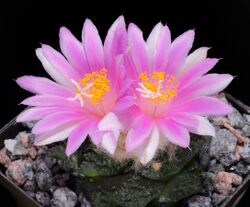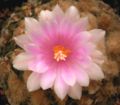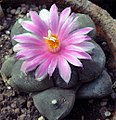Biology:Ariocarpus fissuratus
| Ariocarpus fissuratus | |
|---|---|

| |
| Scientific classification | |
| Kingdom: | Plantae |
| Clade: | Tracheophytes |
| Clade: | Angiosperms |
| Clade: | Eudicots |
| Order: | Caryophyllales |
| Family: | Cactaceae |
| Subfamily: | Cactoideae |
| Genus: | Ariocarpus |
| Species: | A. fissuratus
|
| Binomial name | |
| Ariocarpus fissuratus (Engelm.) K.Schum.[3]
| |
| Synonyms[3] | |
| |
Ariocarpus fissuratus (formerly known as Anhalonium fissuratus) is a species of cactus found in small numbers in northern Mexico and Texas in the United States . Common names include living rock cactus, false peyote, chautle,[3] dry whiskey and star cactus.[4]
Description
This cactus, flattened to spherical bodies 1.5 to 10 cm high and up to 10 (rarely up to 15) cm in diameter, consists of many small tubercles growing from a large succulent tap root. They are usually solitary, almost always remain unbranched, rarely giving rise to side shoots from old areoles. The plant is greyish-green in color, but the flat forms in particular turn yellowish to brownish tint with age. Its growth rate is extremely slow. The spirally distributed warts are flattened, triangular to rhombic and sometimes overlap. The horny, hardened upper surface of each wart is almost completely split and furrowed transversely by a pronounced furrow that connects the areole and axilla. Due to the wool emerging from the furrows, which is initially straw-blond, then darkens and finally grays, the tops of the plants are well protected and usually hidden from view. Sooner (in nature) or later (in culture) the wool is shed, so that the furrows of older warts are almost bare. Thorns are not formed. A. fissuratus is naturally camouflaged in its habitat, making it difficult to spot.[4] When they are found, it is usually due to their pinkish flowers which bloom in October and early November.[4] The flowers develop individually from the youngest areole furrows, so they are almost centrally located. They are light purple to pinkish red with a darker throat and reach a diameter of about 2.5 to 4.5 cm. The pollen is orange-colored, the five to ten-rayed and tiny pinnate stigmas above the stamens are almost white. After fertilization, spindle- to club-shaped, greenish to white fruits 5 to 15 mm long and 2 to 6 mm in diameter are formed. These dry out when ripe and release the dull black seeds into the crown wool, from which they are only washed out (in nature) after a long time.
In its natural habitat, the flattened and yellowish form in particular can hardly be recognized as a plant due to its semi-subterranean growth and the jagged warts (mimesis).
The chromosome count is 2n=22.[5][6]
Distribution
Ariocarpus fissuratus is widespread in southwest Texas from Big Bend National Park to the Pecos River and in the Mexican states of Coahuila, Chihuahua, Durango, Nuevo León, Tamaulipas and Zacatecas.
Taxonomy
The first description as Mammillaria fissurata was by George Engelmann in 1856. Karl Moritz Schumann placed the species in the genus Ariocarpus in 1894.[7] Further nomenclature synonyms are Anhalonium fissuratum (Engelm.) Engelm. (1856) and Roseocactus fissuratus (Engelm.) A. Berger (1925).[8]
Cultivation
In cultivation, Ariocarpus fissuratus is often grafted to a faster-growing columnar cactus to speed growth, as they would generally take at least a decade to reach maturity on their own. They require very little water and fertilizer, a good amount of light, and a loose sandy soil with good drainage.
Poaching
Tens of thousands of this protected Texas cacti are annually removed Illegally.[9] Poaching has even extended to Big Bend National Park. Smugglers have taken entire populations of A. fissuratus, primarily for collectors, mainly in Europe and Asia. Loss of such a wide range of genetic variation weakens the species' chances of future survival.[10] According to the U.S. Department of Justice, the cactus is protected by the Convention on International Trade in Endangered Species of Wild Fauna and Flora (CITES).[11]
Psychoactivity
Ariocarpus fissuratus is a unique species in that it has been used by Native American tribes as a mind-altering substance, usually only as a substitute for peyote.[12] While it does not contain mescaline like species such as peyote, it has been found to contain other centrally active substances, such as N-methyltyramine, N-Methyl-3,4-Dimethoxy-β-Phenethylamin , and hordenine,[12] albeit in doses too small to be active.
References
- ↑ Fitz Maurice, B.; Sotomayor, M.; Terry, M.; Heil, K.; Fitz Maurice, W.A.; Hernández, H.M.; Corral-Díaz, R. (2017). "Ariocarpus fissuratus". The IUCN Red List of Threatened Species (IUCN) 208: e.T152093A121435805.. doi:10.2305/IUCN.UK.2017-3.RLTS.T152093A121435805.en.
- ↑ "Appendices | CITES". https://cites.org/eng/app/appendices.php.
- ↑ 3.0 3.1 3.2 {{citation | mode = cs1 | title = Ariocarpus fissuratus | work = Germplasm Resources Information Network (GRIN) | url = | publisher = [[Organization:Agricultural Research ServAgricultural Research Service (ARS), United States Department of Agriculture (USDA) | access-date = 2010-10-02 }}
- ↑ 4.0 4.1 4.2 Morey, Roy (2008). Little Big Bend : Common, Uncommon, and Rare Plants of Big Bend National Park. Lubbock: Texas Tech University Press. pp. 43. ISBN 9780896726130. OCLC 80359503.
- ↑ Weedin, James F.; Powell, A. Michael (1978). "Chromosome Numbers in Chihuahuan Desert Cactaceae. Trans-Pecos Texas". American Journal of Botany (Botanical Society of America) 65 (5): 531–537. ISSN 0002-9122. http://www.jstor.org/stable/2442586. Retrieved 2023-10-22.
- ↑ Anderson, Edward F. (1960). "A Revision of Ariocarpus (Cactaceae). I. The Status of the Proposed Genus Roseocactus". American Journal of Botany (Botanical Society of America) 47 (7): 582–589. ISSN 0002-9122. http://www.jstor.org/stable/2439437. Retrieved 2023-10-22.
- ↑ Arts, American Academy of (1852). "Proceedings of the American Academy of Arts and Sciences". Metcalf and Co. https://www.biodiversitylibrary.org/page/3101114.
- ↑ Engler, Adolf (1898). "Botanische Jahrbücher fur Systematik, Pflanzengeschichte und Pflanzengeographie". Schweizerbart [etc.]. https://www.biodiversitylibrary.org/page/208562.
- ↑ Walker, R, "Texas's cactus cops battle to save rare desert beauty from smuggling gangs" [1], The Guardian , 20 June 2020. Retrieved 21 June 2020.
- ↑ Barrus, A. "Special Agents and Partners Strike Major Blow to Cactus Black Market" [2], U.S. Fish and Wildlife Service , 2019. Retrieved 21 June 2020.
- ↑ U.S. Attorney's Office [" El Paso Man Pleads Guilty to Role in Scheme to Sell Protected Cacti" https://www.justice.gov/usao-wdtx/pr/el-paso-man-pleads-guilty-role-scheme-sell-protected-cacti], ' Department of Justice , June 2020. Retrieved 21 June 2020.
- ↑ 12.0 12.1 Ratsch, C: "The Sun", page 67. Park Street Press, 2005
- Ratsch, C. (2005). The Encyclopedia of Psychoactive Plants: Ethnopharmocology and its Applications, Vermont: Park Street Press. ISBN:0-89281-978-2
External links
Wikidata ☰ Q138341 entry
 |






